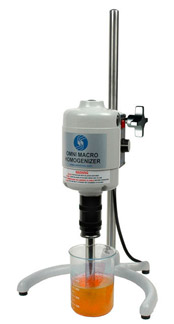Emulsion Tips and Techniques
Emulsification Techniques
The appearance, texture, and stability of an emulsion depend both on its ingredients and on how you prepare it. There are several tools you can use to make an emulsion but the higher the force, the smaller the droplets in the emulsion and the more stable it will be.
Handheld whisk
Using a handheld whisk will produce the weakest emulsions but it may be more than enough if you prepare it right before serving. Some emulsions, such as mayonnaise, can be mixed by hand and will stay stable in the refrigerator for days, even weeks. But one problem with mayonnaise is that it can curdle or invert. That is, the ratio of oil added to eggs and other ingredients can cause clumps of butter-like water-in-oil emulsion bits to form. This makes the finished product less than ideal.
Immersion blender
Use an immersion blender for small quantities or when you need to make the emulsion while heating. To combat the previously mentioned problem when making mayonnaise, try using an immersion blender. In fact, this genius post at Serious Eats demonstrates a fool-proof way to make mayonnaise using an immersion blender and a tall plastic container.
Blender
If you're making larger batches of emulsion, nothing beats a powerful blender. Use traditional blender for larger quantities or for more difficult emulsions that need more power. Commercial blenders have more power than household blenders and produce better emulsions with smaller droplets.
The quality of a blender-made emulsion depends on two factors: shear stress and carafe shape. Shear has to do with the speed at which the blender's blades turn through a liquid. The faster the shear, the smaller the particles in an emulsion. The smaller the particles, the creamier the result, until the particles are so small that your tongue can no longer distinguish them, resulting in a milk-like texture. In addition to shear, the size and shape of a blender's carafe determine the blade's ability to fully interact with all of the carafe's contents. If only a small portion of an emulsion benefits from maximum shear, the end result will still be poor.
The most widely used blender for professional kitchens are made by Vitamix, but many cheaper models are available for home cooks. For a comprehensive review of blenders, see this article.
 Rotor-stator homogenizer
Rotor-stator homogenizer
Not a traditional kitchen tool and expensive, rotor-stator homogenizers are used to make fine emulsions. It generates much higher shear forces than a regular blender thanks to the two blades that move very close to each other to produce fine emulsions. One of the blades is stationary and the other one rotates. (shown in left picture)
Ultrasonic homogenizer
Another expensive lab tool usually used to make an existing emulsion even finer through mechanical vibrations that create microscopic bubbles.
High-pressure homogenizer
The ultimate lab tool to make the finest emulsions ever works by applying pressure to the liquid.
Emulsion Tips
In addition to picking the right emulsifier for the desired application and using the right tool as described above, there are a few other things to consider when making an emulsion.
Viscocity
An emulsion can be made more stable by increasing the viscocity (thickening) of the continuous phase in the emulsion as this makes it more difficult for the dispersed droplets to move and combine. Remember that in an O/W emulsion the continuous phase is the water and in an W/O emulsion the continuous phase is the oil. So adding a thickener to the continuous phase can help you make the emulsion more stable. This is a widely used technique and that's why you'll frequently see the use of thickeners and emulsifiers combined to make effective stable emulsions.
Density
Mixing oil and water is not only hard because of the polar differences but also because of the difference in density. The oil molecules are lighter than the water molecules but if you make the oil heavier, the emulsion will be more stable. This is not usually necessary in most culinary applications.
Speed of incorporating ingredients
When making an emulsion, it is usually better to disperse the emulsifier first in the continuous phase and then slowly incorporate the dispersed phase while you are mixing with the selected tool.





